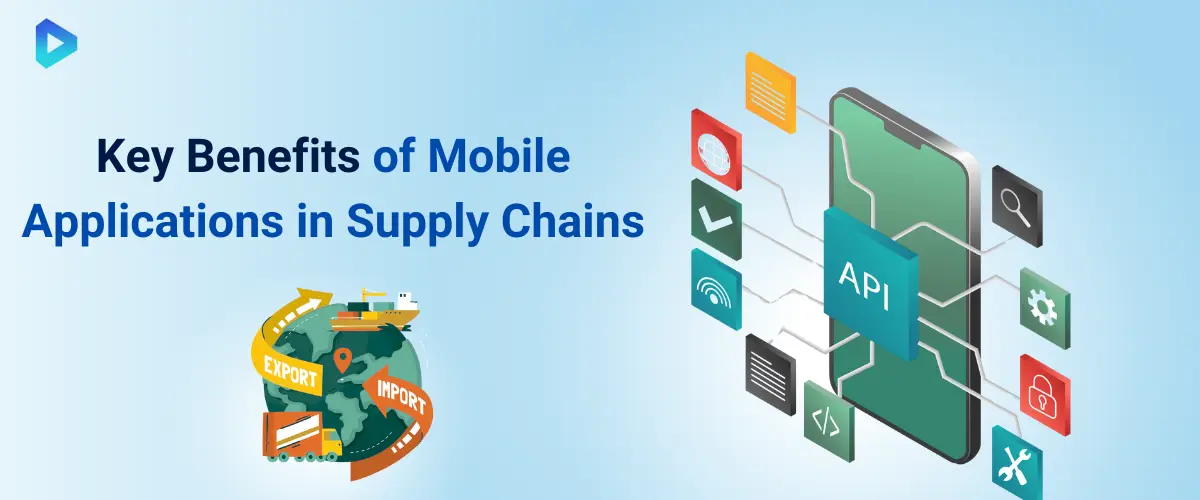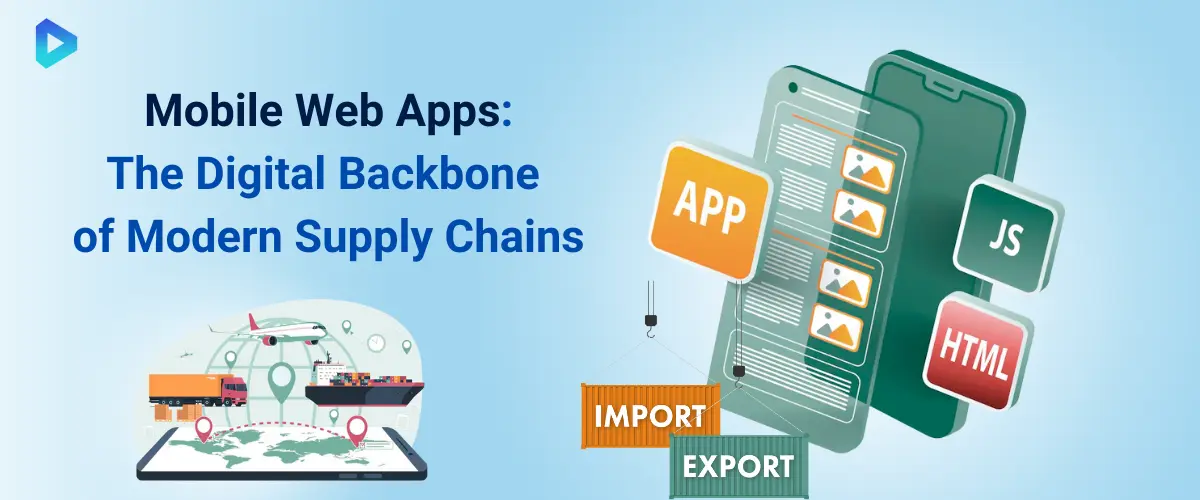Your supply chain is only as strong as its weakest link—and outdated systems are often the culprit. Enter mobile web apps: the secret weapon for logistics companies looking to boost efficiency and cut costs.
With features like real-time tracking, automated workflows, and seamless vendor communication, these apps are changing the game. But where do you start?
This blog post will explore why mobile web apps are non-negotiable for modern supply chains, how they reduce operational expenses, and the key features your business needs. The future of logistics is here—are you ready?
What Is a Mobile Web App in the Supply Chain Business?
Mobile web apps are transforming supply chains by making logistics management accessible anytime, anywhere.
 Defining Mobile Web Apps for Supply Chain Operations
Defining Mobile Web Apps for Supply Chain Operations
Mobile web apps are browser-based tools optimized for smartphones that help manage supply chain tasks. These apps facilitate real-time tracking of shipments, inventory levels, and order statuses, enabling supply chain professionals to make informed decisions on the go. They work without downloads and update automatically.
Key features for supply chains:
- Real-time shipment tracking
- Inventory management on the go
- Instant communication with drivers/vendors
Example: A warehouse manager checks stock levels during lunch using their phone's browser. No app store visit required.
How Mobile Web Apps Differ from Native Apps
Mobile web apps run in browsers, while native apps install directly on devices. For supply chains, web apps win with:
- No storage space needed
- Updates happen automatically
- Work across all device types
But native apps may work offline better. Most supply chains prefer web apps for their flexibility and lower maintenance.
Real-World Examples of Supply Chain Mobile Web Apps
Companies like DHL and FedEx use mobile web apps to provide real-time tracking and inventory management. These apps enable users to monitor shipments and manage logistics efficiently from any mobile device.
Leading companies use mobile web apps for:
- Delivery Tracking: Drivers update statuses via browser
- Inventory Checks: Scan barcodes using phone cameras
- Vendor Portals: Suppliers access schedules anywhere
A food distributor reduced late deliveries by 25% after implementing a delivery tracking web app their drivers could use on any phone.
How to Turn a Web App Into a Mobile App?
Transforming your web app into a mobile app can enhance user experience and operational efficiency.
 Exploring the Basics of App Transformation
Exploring the Basics of App Transformation
Converting a web app into a mobile app involves creating a version optimized for mobile devices. This ensures better performance and user engagement.
- Responsive Design: Adjusts layout based on screen size.
- Progressive Web Apps (PWAs): Web apps with app-like experiences.
- Hybrid Apps: Combine web technologies with native app features. Understanding these basics helps in choosing the right approach for your supply chain needs.
Key Steps to Convert Your Web App for Mobile
Transitioning to a mobile app requires careful planning and execution.
- Assess Current Web App: Identify features to retain or modify.
- Choose a development approach like Native, Hybrid, or PWA
- Design Mobile UI/UX: Ensure intuitive navigation and usability.
- Develop and Test: Build the app and conduct thorough testing.
- Deploy: Publish to app stores and monitor performance.
Following these steps ensures a smooth transition to a mobile platform.
Why Are Mobile Web Apps Important for Supply Chain Businesses?
Mobile web apps keep supply chains agile, connected, and efficient in today's fast-moving world.
 The Growing Need for On-the-Go Supply Chain Access
The Growing Need for On-the-Go Supply Chain Access
Modern supply chains demand real-time access from anywhere. Mobile web apps let managers approve shipments, drivers update deliveries, and warehouses check inventory—all from their smartphones.
Key drivers:
- 73% of logistics pros now use mobile devices daily
- Cloud-based access eliminates location barriers
- Instant updates prevent costly delays
Example: A produce distributor reduced spoiled goods by 18% using mobile quality checks during transit.
How Mobile Apps Improve Supply Chain Responsiveness?
Mobile solutions slash response times dramatically:
- Delivery issues get reported and solved 3x faster
- Inventory adjustments happen in real time.
- Emergency rerouting takes minutes not hours
A textile company cut customer complaint resolution time from 8 hours to 90 minutes after going mobile.
Business Scenarios Where Mobile Web Apps Shine
These apps excel in critical moments:
- Last-Mile Delivery: Drivers confirm drop-offs instantly
- Warehouse Audits: Staff update stock levels on the floor
- Supplier Coordination: Instant PO approvals from anywhere
Case Study: An auto parts supplier reduced backorders by 40% after implementing mobile inventory updates from their warehouse aisles.
How Can a Web Application Reduce the Operational Cost of a Supply Chain?
Web apps slash supply chain costs through smart automation and real-time visibility.
 Cutting Costs Through Automation and Real-Time Tracking
Cutting Costs Through Automation and Real-Time Tracking
Web apps automate repetitive tasks like order processing and shipment updates. Real-time GPS tracking eliminates check-in calls and reduces fuel waste from inefficient routes.
Key savings:
- 30-50% less time spent on admin tasks
- 15-25% fuel savings from optimized routing
- Instant exception alerts prevent costly delays
Example: A beverage company saved $250k/year in fuel costs after implementing route optimization in their web app.
Reducing Manual Errors and Paperwork
Digital workflows in web apps prevent expensive mistakes:
- Automated data entry cuts errors by up to 90%
- Electronic documentation reduces paper costs by 60-80%
- Digital approvals slash processing time from days to minutes
A mid-sized retailer eliminated $75k in annual inventory discrepancies after switching to mobile barcode scanning.
Quantifying Savings: A Cost-Benefit Analysis
Typical web app ROI for supply chains:
Implementation Cost:
- 10-20k
- 20k−50k
Annual Savings:
- $45k in labor (3 FTEs redirected)
- $30k in fuel/transport
- $25k in error reduction
Payback Period: 6-12 months
Example: A frozen food distributor achieved a 212% ROI in 9 months by digitizing their cold chain monitoring.
What Are the Key Benefits of a Mobile Web App for Supply Chain?
Mobile web apps give supply chains real-time visibility, cost savings, and instant decision-making power from anywhere.
 Improved Visibility Across Supply Chain Operations
Improved Visibility Across Supply Chain Operations
Mobile web apps act like a live dashboard for your entire supply chain. Managers see inventory levels, shipment locations, and delays instantly on their phones.
Key visibility benefits:
- Track goods from warehouse to customer
- Monitor supplier performance in real time.
- Spot bottlenecks before they cause delays
Example: A furniture company reduced "Where's my order?" calls by 60% after implementing mobile tracking.
Real-Time Tracking, Alerts, and Communication Advantages
Get instant notifications about important events:
- Delivery delays trigger automatic alerts
- Low inventory warnings prevent stockouts
- Drivers message dispatchers directly through the app
A food distributor reduced spoiled shipments by 25% using temperature alerts during transit.
Better Decision-Making Through Centralized Data Access
All supply chain data lives in one mobile-accessible place:
- Compare vendor prices during negotiations
- Check inventory while meeting with clients
- Approve urgent orders from the road
Example: A construction supplier closed 30% more deals after giving sales reps mobile access to live inventory data.
How to Integrate Mobile Web Apps into Your Supply Chain Strategy?
Mobile web apps boost supply chain efficiency when implemented thoughtfully—here's how to do it right.
 Planning for Smooth Adoption Across Your Supply Chain Teams
Planning for Smooth Adoption Across Your Supply Chain Teams
Start by identifying pain points the app will solve for each team—warehouse, logistics, and procurement. Roll out features gradually, beginning with the most impactful ones like real-time tracking or digital documentation.
Key steps:
- Pilot with a small team first
- Choose intuitive, role-specific features
- Phase implementation over 2-3 months
Example: A textile company trained warehouse staff first, then drivers, reducing adoption headaches by 40%.
Aligning App Integration with Business Goals
Match app features to your top supply chain priorities:
- Cost Reduction? Focus on route optimization
- Speed? Implement real-time tracking
- Accuracy? Add barcode scanning
A seafood distributor aligned their app with freshness goals, cutting spoilage by 30% through temperature monitoring.
Training, Support, and Feedback Loops for Long-Term Success
Ongoing support ensures teams actually use the app:
- Create 2-minute video tutorials for each feature
- Assign "app champions" in each department
- Collect weekly feedback for improvements
Tip: A hardware supplier improved app usage by 60% after adding a simple "help" chat button.
Key Takeaways
Mobile web apps are revolutionizing supply chains by delivering real-time visibility, automation, and cost savings. Here’s what you need to know:
✅ Operational Efficiency – Streamline workflows, reduce manual errors, and cut costs by 20-40%.
✅ Live Tracking – Monitor shipments, inventory, and deliveries from anywhere, minimizing delays.
✅ Data-Driven Decisions – Centralized access to analytics improves responsiveness and accuracy.
✅ Easy Adoption—Start small with pilot features, then scale based on team feedback.
✅ Scalability – Cloud-based updates ensure your app grows with your business needs.
Next Step: Identify one pain point (e.g., delivery tracking) and test a mobile web app solution!



Leave your thought
Send us a Message
Contact Info
[email protected]
[email protected]
+91-62661-63663
[email protected]